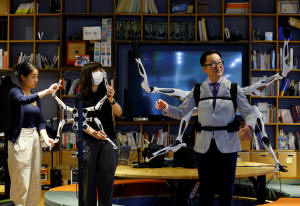|
Inami's team is developing a series of technologies rooted in
the idea of "jizai", an Japanese term that he says roughly
denotes autonomy and the freedom to do as one pleases.
The aim is to foster something like the relationship between
musician and instrument, "lying somewhere between a human and a
tool, like how a musical instrument can become as if a part of
your body."
Inami says he was inspired by traditional Japanese puppetry and
a quasi-horror short story by novelist Yasunari Kawabata about a
man who borrows a young woman's arm and proceeds to spend the
night with it.
"This is absolutely not a rival to human beings, but rather
something that helps us do as we please, like a bicycle or
e-bike. It supports us and can unlock creativity," Inami said.
A promotional video for the "Jizai Arms" shows two ballet
dancers performing a routine with robotic arms protruding from
their backs and torsos - human and machine moving in concert.
The dancers ultimately embrace, cyborg arms included.
Some wearers grow attached to the arms after some time, Inami
said. "Taking them off after using them for a while feels a
little sad. That's where they're a little different to other
tools," he said.
But the potential goes beyond turning a novelist's fantasy into
reality, such as helping in search-and-rescue missions, he
added. "In the future we might see wings growing out of people's
backs, or drones attached to people ... Maybe someone will come
up with a sport that requires six arms or invent a new type of
swimming," Inami said.
(Reporting by Anton Bridge and Tom Bateman; Editing by Chang-Ran
Kim and Stephen Coates)
[© 2023 Thomson Reuters. All rights
reserved.] Copyright 2022 Reuters. All rights reserved. This material may not be published,
broadcast, rewritten or redistributed.
Thompson Reuters is solely responsible for this content.

|
|



